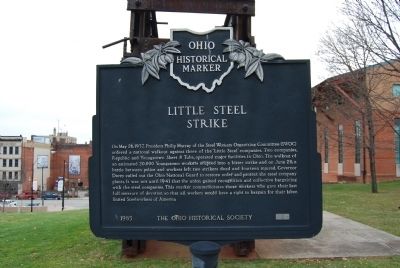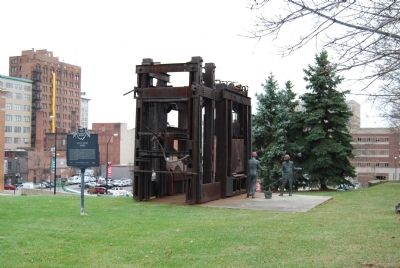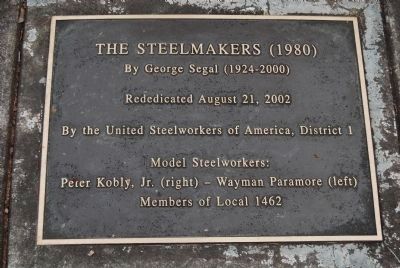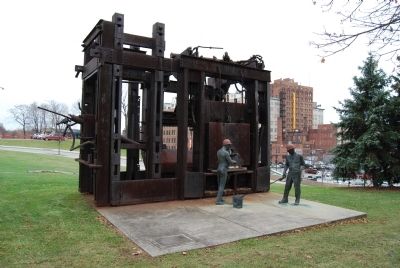Youngstown in Mahoning County, Ohio — The American Midwest (Great Lakes)
Little Steel Strike
Erected 1985 by The Ohio Historical Society. (Marker Number 15-50.)
Topics and series. This historical marker is listed in these topic lists: Industry & Commerce • Labor Unions. In addition, it is included in the Ohio Historical Society / The Ohio History Connection series list. A significant historical month for this entry is May 1957.
Location. 41° 6.168′ N, 80° 39.046′ W. Marker is in Youngstown, Ohio, in Mahoning County. Marker is at the intersection of West Wood Street and North Hazel Street, on the right when traveling east on West Wood Street. Located to the left of the Youngstown Historical Center for Industry and Labor. Touch for map. Marker is in this post office area: Youngstown OH 44503, United States of America. Touch for directions.
Other nearby markers. At least 8 other markers are within walking distance of this marker. A Little Bit of Youngstown’s History (within shouting distance of this marker); Working Class Heroes (within shouting distance of this marker); The Warner Theater (about 800 feet away, measured in a direct line); 1959-1975 The Vietnam War (approx. 0.2 miles away); Union National Bank Building / Central Square (1798-1899) (approx. 0.2 miles away); In Memory of the Heroes of the Township (approx. 0.2 miles away); Harry Burt and Good Humor / Ross Radio Company (approx. 0.2 miles away); Central Tower / Mahoning National Bank Building (approx. 0.2 miles away). Touch for a list and map of all markers in Youngstown.
More about this marker. The marker number has been ground down from both sides of the marker, most likely because this is the previous decommissioned version of this historical marker. The newer marker, a two-sided marker numbered 15-50 and titled “The Little Steel Strike of 1937” is listed as missing on the Ohio History Connection listing. On March 22, 2021, a visit to this location found this, the old marker, present and no sign
of the newer missing marker.
Also see . . . Little Steel Strike of 1937. Ohio History Central (Submitted on December 8, 2014, by Mike Wintermantel of Pittsburgh, Pennsylvania.)
Additional commentary.
1. The Little Steel Strike of 1937
Text of marker 15-50, the replacement for this marker, that has gone missing from this location.
The Committee for Industrial Organization, later called the Congress of Industrial Organizations (CIO), formed the Steel Workers Organizing Committee (SWOC) under the leadership of CIO president John L. Lewis in April 1936. Following successful CIO strikes in the rubber and automobile industries, SWOC won contracts in early 1937 with the United States Steel Corporation and Jones and Laughlin Steel, the largest steel makers in the United States, also known as "Big Steel." On May 26, 1937, SWOC struck three "Little Steel" companies whose operations were concentrated in the Mahoning Valley: Inland Steel, Republic Steel, and Youngstown Sheet and Tube. By early June, the first major steel strike since 1919 idled more than 28,000 Canton, Warren, and Youngstown steelworkers.
No negotiated settlement emerged, despite the intervention of Governor William Davey and the federal Steel Mediation Board. In Youngstown, rioting on June 9th and 19th killed two strikers and wounded 23 other participants. The Little Steel companies reopened their local mills in late June, and the strike ended in this region by early July. Despite this setback, SWOC charged Little Steel with unfair labor practices before the new National Labor Relations Board and won signed contracts in the Mahoning Valley mills by 1942. As one of the most violent strikes of the 1930s, the Little Steel Strike led to a division between organized labor and the New Deal-era Democratic Party.
The new marker was erected by the Ohio Bicentennial Commission, Greater Youngstown AFL-CIO Labor Council, and The Ohio Historical Society.
— Submitted March 24, 2021, by J. J. Prats of Powell, Ohio.
Credits. This page was last revised on March 24, 2021. It was originally submitted on December 8, 2014, by Mike Wintermantel of Pittsburgh, Pennsylvania. This page has been viewed 633 times since then and 39 times this year. Photos: 1, 2, 3, 4. submitted on December 8, 2014, by Mike Wintermantel of Pittsburgh, Pennsylvania.



